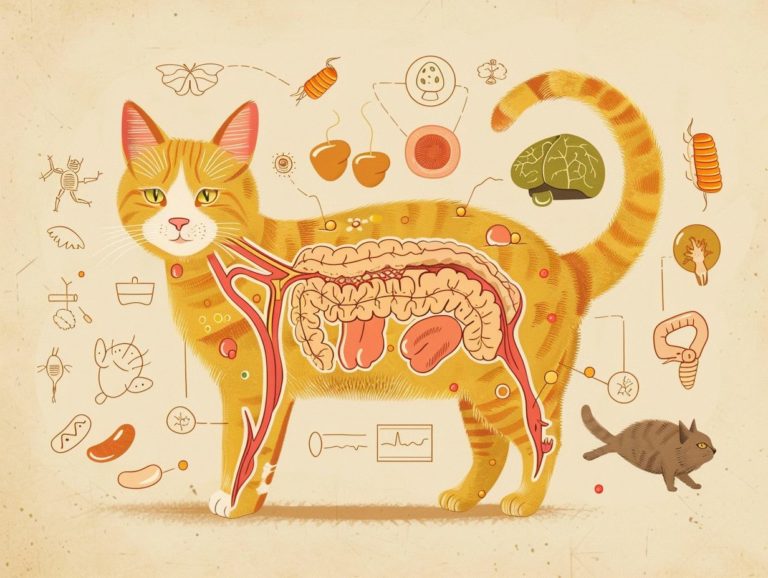How To Recognize And Treat Respiratory Infections In Cats
This article provides information on the types of respiratory infections in cats, including their causes, symptoms, treatment, prevention, and when to seek medical attention. The aim is to educate and empower cat owners with the essential knowledge to ensure the health and well-being of their feline companions.
Key Takeaways:
Understanding Respiratory Infections in Cats
Understanding Respiratory Infections in Cats is essential for every cat owner to safeguard the health and well-being of their feline companions. These infections primarily impact the upper respiratory tract and are triggered by a range of pathogens, encompassing viruses, bacteria, and fungi.
Viral respiratory infections in cats are predominantly attributed to feline herpesvirus and calicivirus, manifesting symptoms like sneezing, nasal discharge, and conjunctivitis. Bacterial infections typically stem from pathogens such as Bordetella bronchiseptica and Mycoplasma felis, leading to more severe manifestations like coughing and dyspnea.
While less common, fungal infections like cryptococcosis and aspergillosis can also compromise a cat’s respiratory health, underscoring the importance of early identification and appropriate intervention.
Types of Infections and Common Causes
Respiratory infections in cats can be broadly categorized as viral, bacterial, and fungal infections. Common viral infections in cats include Feline Herpes Virus and Feline Calicivirus, bacterial infections such as Chlamydophila felis, and fungal infections like Cryptococcus neoformans. These infections typically target the upper respiratory tract of cats, leading to symptoms such as sneezing, coughing, nasal discharge, and ocular discharge.
Feline Herpes Virus, a highly contagious viral pathogen, is commonly transmitted through direct contact with the saliva or discharge of an infected cat. Bacterial infections, such as those caused by Chlamydophila felis, can be spread through close contact with infected animals or by sharing contaminated objects. Understanding these pathogens, their modes of transmission, and associated risk factors can help cat owners implement appropriate preventive measures for their pets.
Signs and Symptoms of Respiratory Infections
Recognizing the signs and symptoms of respiratory infections in cats is crucial to initiating early treatment. Cats may exhibit various clinical signs such as sneezing, nasal discharge, coughing, and lethargy when they have a respiratory infection. Additionally, cats with respiratory infections may display symptoms of fever, difficulty breathing (dyspnea), loss of appetite (anorexia), and ocular discharge. The severity of these symptoms will vary depending on the underlying cause of the infection, whether viral, bacterial, or fungal in origin.
Diagnosing respiratory infections in cats may involve physical examinations, blood tests, x-rays, and swabs of nasal or throat secretions for further analysis. If left untreated, respiratory infections can progress to more serious complications such as pneumonia or chronic respiratory conditions.
Identifying and Monitoring Symptoms
The process of identifying and monitoring symptoms in cats with respiratory infections involves a detailed evaluation of their clinical presentation and appropriate diagnostic tests to confirm the underlying infection. Early diagnosis is crucial for timely treatment and improving prognosis.
The process typically begins with recognizing common respiratory infection symptoms in cats, including coughing, sneezing, nasal discharge, and lethargy. A veterinarian then conducts a physical examination to assess the overall health of the cat and to identify specific clinical signs such as fever or abnormal lung sounds.
Additional diagnostic tests such as blood work, radiographs, or a nasal swab may be conducted to determine the specific virus or bacteria causing the infection. Once the infectious agent is identified, treatment options, medications, supportive care, and sometimes isolation can be customized to address individual needs.
Treating Respiratory Infections in Cats
The treatment of Respiratory Infections in Cats involves a variety of approaches, including medication (such as antibiotics), supportive care, and environmental management. Effective treatment aims to alleviate clinical signs, address the infectious cause, and promote the overall health of the infected cat.
Medication: Cats with respiratory infections may be prescribed antibiotics to treat bacterial infections, antivirals for feline herpesvirus infections, and anti-inflammatory drugs to reduce inflammation in the respiratory tract.
Supportive care: Providing proper hydration, minimizing stress by creating a quiet environment, and ensuring good ventilation are examples of supportive care that can aid in the cat’s recovery at home.
Home care: Practices such as monitoring symptoms regularly, cleaning nasal discharge with a mild saline solution, and offering warm and palatable food at regular intervals can help manage the respiratory infection at home.
Complications: Complications of respiratory infections in cats, such as secondary bacterial infections or the development of chronic respiratory diseases, often require veterinary intervention.
Medications and Home Care
The most common treatments for respiratory infections in cats involve medications and home care. Antibiotics, antivirals, and supportive therapies are used to help treat these infections. Providing a stress-free environment at home can also aid in the cat’s recovery process.
The dosage of medications like amoxicillin or doxycycline depends on the cat’s weight and the severity of the infection. Typically administered orally, these medications may require injections in some cases. It is essential to strictly follow the veterinarian’s instructions to ensure the correct dosage and duration of treatment.
Creating a safe, quiet, and warm resting place for your cat can help reduce stress and support healing. Maintaining a clean litter box and offering easily digestible food along with clean water can assist in your cat’s recovery.
Preventing Respiratory Infections
Preventing Respiratory Infections in Cats significantly impacts their quality and length of life. Vaccination against common pathogens such as Feline Herpes Virus and Feline Calicivirus, maintaining good hygiene practices, and reducing stress levels all contribute to preventing respiratory infections.
Regular veterinary check-ups increase the likelihood that your cat will be current on necessary vaccinations. Proper ventilation in your home, clean litter boxes, and the use of air purifiers all help reduce the risks associated with respiratory infections. Providing proper nutrition and regular exercise can also boost your cat’s immune system, lowering the risk of infections.
By incorporating these preventative measures into your cat’s routine, you can ensure a healthier lifestyle that minimizes the risk of future infections.
Tips for Keeping Your Cat Healthy
Ensuring the health and well-being of your cat involves taking preventive measures and reducing risk factors associated with respiratory infections. This includes scheduling regular veterinary check-ups, providing proper nutrition, and creating a relaxing environment.
Regular grooming helps prevent the accumulation of dust and allergens in your cat’s fur that could worsen respiratory issues. Ensuring proper ventilation in your cat’s living space can decrease the likelihood of respiratory infections.
Regular exercise and mental stimulation, which also help prevent stress, contribute to maintaining a strong immune system. Keeping your cat’s vaccinations and parasite prevention up to date is essential for disease prevention.
When to Seek Veterinary Care
Recognizing when to seek veterinary care for your cat’s respiratory symptoms is crucial for timely diagnosis and treatment. Certain warning signs, such as severe breathing difficulties, persistent coughing, or visible nasal discharge, should prompt you to seek immediate veterinary attention. If your cat displays signs of lethargy, loss of appetite, or a high fever, it may indicate a more serious underlying respiratory infection that necessitates veterinary intervention.
During an examination, the veterinarian may conduct diagnostic tests like bloodwork, X-rays, or respiratory swabs to pinpoint the exact cause of the infection. Treatment options may include antibiotics, antiviral medications, or supportive care to alleviate symptoms. In emergency situations, hospitalization for oxygen therapy or more intensive treatment may be necessary. Adhering to the veterinarian’s instructions for follow-up care and monitoring is essential for your cat’s long-term prognosis.
Warning Signs and Emergency Situations
It is essential to recognize warning signs and emergency situations in cats with respiratory infections for timely intervention and improved outcomes. Signs such as a rapid respiratory rate, blue mucous membranes, and lethargy indicate the need for immediate veterinary attention to address potentially life-threatening conditions. Severe coughing, wheezing, or difficulty breathing are signs of more serious respiratory disease and can be an emergency if the cat is in respiratory distress.
Cats showing symptoms like nasal discharge, sneezing, or a persistent fever should be promptly seen by a veterinarian. Respiratory infections in cats can quickly progress to pneumonia or respiratory distress if left untreated. Veterinary care for cats with respiratory infections involves diagnostic tests, such as bloodwork and x-rays, to identify the underlying cause and establish an appropriate treatment plan.
Swift management of respiratory infections in cats is crucial to prevent complications.
Frequently Asked Questions
What are some common symptoms of respiratory infections in cats?
Common symptoms of respiratory infections in cats include sneezing, coughing, runny nose and eyes, difficulty breathing, and loss of appetite.
How can I tell if my cat has a respiratory infection or just a cold?
If your cat’s symptoms last longer than a week or if they seem to be getting worse, it is likely a respiratory infection rather than a cold. It’s always best to consult with your veterinarian for a proper diagnosis.
Can respiratory infections in cats be treated at home?
In mild cases, some respiratory infections in cats can be treated at home with antibiotics, decongestants, and supportive care. However, it’s important to monitor your cat closely and seek veterinary care if symptoms worsen.
What are the potential complications of respiratory infections in cats?
If left untreated, respiratory infections in cats can lead to pneumonia, which can be life-threatening. It’s important to seek veterinary care if your cat is showing symptoms of a respiratory infection.
Are there any preventive measures I can take to protect my cat from respiratory infections?
Keeping your cat up-to-date on vaccinations and avoiding contact with sick cats can help prevent respiratory infections. It’s also important to keep your cat’s environment clean and provide a healthy diet to boost their immune system.
Can humans catch respiratory infections from their cats?
While rare, some respiratory infections in cats can be transmitted to humans. It’s important to practice good hygiene, such as washing your hands regularly, when caring for a sick cat.

